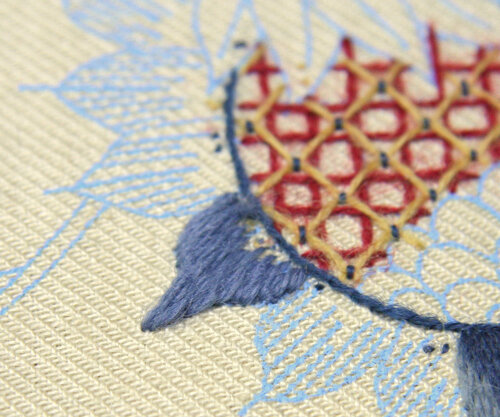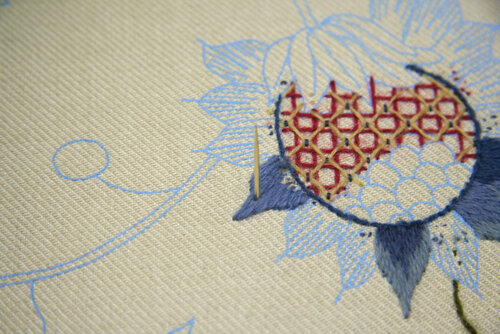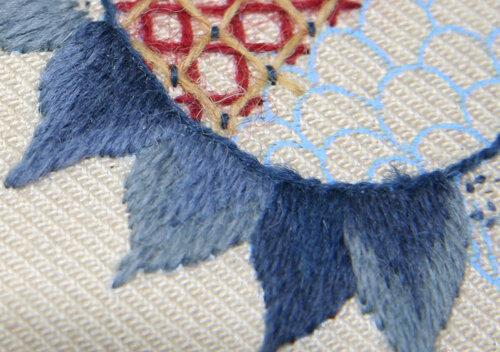Long and Short Shading - two tricks that helped me
When I was first teaching myself long and short shading, everything I did looked artificial and chunky. None of that lovely, soft gradual shading that I saw on other people's work. Mine was a block of color next to another block of color. I took the "long and short" literally, making only two lengths of stitch - one long and one short. Then I worked with Phillipa Turnbull and Tracy Franklin and Nicola Jarvis and got the idea (finally!) that it's really longer and shorter stitches that are the first step to making this stitch look it's best. The second trick is to make your first layer of stitches go a long way into the shape - really, really deeply into the shape. (see above) Farther than you think is correct and then a little farther. And don't panic, because if you do go "too far" you can just put the next layer of stitches over the first layer and it will be fine. In fact, it will be better!A beautiful shape worked in long and short shading is something most of us strive for and many of us dread. And really, the two tricks that helped me the most are 1. "longer and shorter" - vary the length of the stitches quite a bit one to the other and 2. make the first layer go deeply into the shape so the second layer can be stitched deeply into the first.Here's how deeply I went into the first layer of longer and shorter stitches on this flower petal for the Marriage Pillowe. My needle is coming up where I will make the first stitch of the second layer of stitching - the darker color on this petal.
The second trick is to make your first layer of stitches go a long way into the shape - really, really deeply into the shape. (see above) Farther than you think is correct and then a little farther. And don't panic, because if you do go "too far" you can just put the next layer of stitches over the first layer and it will be fine. In fact, it will be better!A beautiful shape worked in long and short shading is something most of us strive for and many of us dread. And really, the two tricks that helped me the most are 1. "longer and shorter" - vary the length of the stitches quite a bit one to the other and 2. make the first layer go deeply into the shape so the second layer can be stitched deeply into the first.Here's how deeply I went into the first layer of longer and shorter stitches on this flower petal for the Marriage Pillowe. My needle is coming up where I will make the first stitch of the second layer of stitching - the darker color on this petal. After I pull the needle through and then back down, the new stitch melts into the first layer of thread. It's the melting or burying of the second layer of stitching into the first layer that helps the threads to blend so beautifully.
After I pull the needle through and then back down, the new stitch melts into the first layer of thread. It's the melting or burying of the second layer of stitching into the first layer that helps the threads to blend so beautifully. One of the things I like about this part of the project is the subtle shift in colors from one petal to the next. The same 3 or 4 shades of blue are used, but the petals use different combinations of the shades of blue. The mixture of shades of blue keep the flower from looking too stiff, yet because all the blue shades are in the same family, they all blend together.
One of the things I like about this part of the project is the subtle shift in colors from one petal to the next. The same 3 or 4 shades of blue are used, but the petals use different combinations of the shades of blue. The mixture of shades of blue keep the flower from looking too stiff, yet because all the blue shades are in the same family, they all blend together. I hope this gives those of you who are having difficulty with long and short shading yet another way to think about the technique. Once you get the hang of it, it's such fun and the results are so pretty! Now, I just have to work on perfecting my technique - practice, practice, practice!
I hope this gives those of you who are having difficulty with long and short shading yet another way to think about the technique. Once you get the hang of it, it's such fun and the results are so pretty! Now, I just have to work on perfecting my technique - practice, practice, practice!
